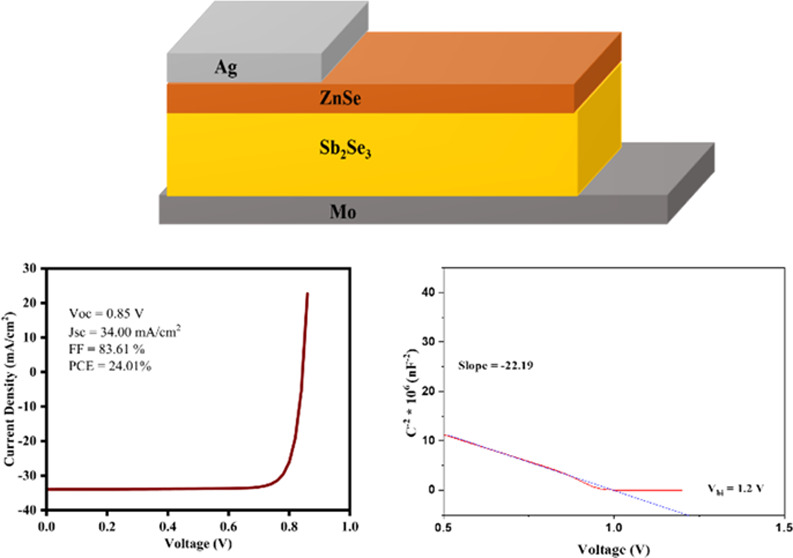- Record: found
- Abstract: found
- Article: found
24% Efficient, Simple ZnSe/Sb 2Se 3 Heterojunction Solar Cell: An Analysis of PV Characteristics and Defects

Read this article at
Abstract

In this work, a new wide-band-gap n-type buffer layer, ZnSe, has been proposed and investigated for an antimony selenide (Sb 2Se 3)-based thin-film solar cell. The study aims to boost the Sb 2Se 3-based solar cell’s performance by incorporating a cheap, widely accessible ZnSe buffer layer into the solar cell structure as a replacement for the CdS layer. Solar Cell Capacitance Simulator in One Dimension (SCAPS-1D) simulation software is used to thoroughly analyze the photovoltaic parameters of the heterojunction structure ZnSe/Sb 2Se 3. It includes open circuit voltage ( V OC), short-circuit current density ( J SC), fill factor (FF), power conversion efficiency (PCE), and external quantum efficiency (EQE). The absorber layer (Sb 2Se 3) thickness is adjusted from 0.5 to 3.0 μm to perfect the device. In addition, the influence of cell resistances, radiative recombination coefficient, acceptor and donor defect concentration in the Sb 2Se 3 layer, and interface defects of the ZnSe/Sb 2Se 3 layer on overall device performance are investigated. The ZnSe buffer layer and the Sb 2Se 3 absorber layer are designed to have optimal thicknesses of 100 nm and 1.5 μm, respectively. The proposed device’s efficiency with optimized parameters is calculated to be 24%. According to the simulation results, it is possible to build Sb 2Se 3-based thin-film solar devices at a low cost and with high efficiency by incorporating ZnSe as an electron transport layer.
Related collections
Most cited references43

- Record: found
- Abstract: found
- Article: found
The toxicity of cadmium and resulting hazards for human health
- Record: found
- Abstract: not found
- Article: not found
Thin-film Sb2Se3 photovoltaics with oriented one-dimensional ribbons and benign grain boundaries
- Record: found
- Abstract: found
- Article: found